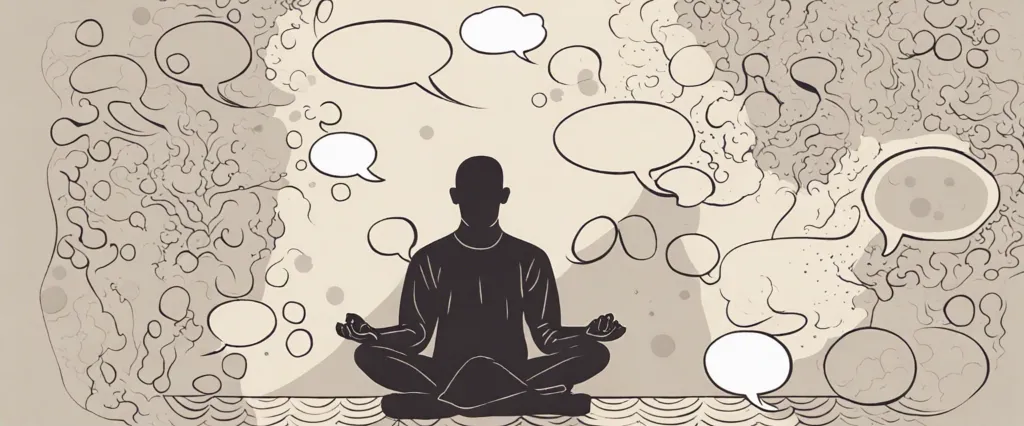In “Mindfulness in Plain English” by Henepola Gunaratana, readers are presented with a comprehensive guide to developing mindfulness meditation skills and incorporating them into daily life. Gunaratana, a renowned Buddhist monk and meditation teacher, brings his deep understanding and personal experience of mindfulness to offer a concise and practical introduction to the practice. This enlightening book offers readers a simple yet profound approach to cultivating present moment awareness, reducing stress, and finding authentic happiness amidst the chaos of everyday life.
Chapter 1: Introduction to Mindfulness: Understanding the Concept and Benefits of Mindfulness Meditation
Chapter 1 of “Mindfulness in Plain English” by Henepola Gunaratana serves as an introduction to the concept and benefits of mindfulness meditation. The chapter begins by addressing the common misconceptions surrounding meditation, highlighting the fact that it is not associated with any specific religious or philosophical doctrines. Instead, the author explains that mindfulness meditation is a technique that helps individuals develop a clear, focused, and non-judgmental awareness of their own experiences.
Gunaratana emphasizes the importance of learning to observe one’s mind and thoughts without getting caught up in them. By cultivating present-moment awareness, individuals can awaken to the reality of their experience rather than living in a state of autopilot. This leads to a deeper understanding of the self and allows individuals to make conscious choices rather than reacting impulsively.
The chapter also discusses the numerous benefits of mindfulness meditation. Gunaratana explains that this practice reduces stress and anxiety by creating a sense of inner calm and tranquility. It enhances self-awareness, helping individuals recognize and transform harmful behavior patterns. Mindfulness fosters emotional intelligence, promoting a compassionate and empathetic approach to oneself and others. Additionally, it improves concentration and focus, leading to increased productivity and efficiency.
Lastly, Gunaratana shares insights into the obstacles that one may encounter when starting a mindfulness practice. Identifying common challenges such as restlessness, boredom, or doubt, he emphasizes the importance of patience and perseverance in overcoming these hurdles.
Overall, Chapter 1 serves as an engaging introduction to the concept of mindfulness meditation, highlighting its practical benefits in daily life. It provides readers with a solid foundation and motivation to explore this transformative practice for themselves.
Chapter 2: The Basics of Meditation: Exploring the Fundamentals of Posture, Breathing, and Focus in Meditation Practice
Chapter 2 of “Mindfulness in Plain English” by Henepola Gunaratana is titled “The Basics of Meditation: Exploring the Fundamentals of Posture, Breathing, and Focus in Meditation Practice.” In this chapter, Gunaratana introduces the foundational elements of meditation, emphasizing the importance of posture, breathing, and focus.
The chapter begins by discussing the significance of posture in meditation. Gunaratana suggests finding a comfortable position that allows for stability and alertness, whether sitting on a cushion, in a chair, or even lying down. He emphasizes maintaining a straight spine to promote attentiveness and discourage drowsiness. The author also explains the importance of stillness in meditation, encouraging practitioners to minimize unnecessary body movements that may disturb concentration.
Next, Gunaratana delves into the role of breathing in meditation. He advocates for natural breathing and discourages any attempt at manipulating or controlling the breath. By observing the breath without interfering, one can develop a heightened awareness of their physical sensations and mental states. Gunaratana advises focusing on the sensation of the breath at a specific point, such as the nostrils or the rising and falling of the abdomen.
The chapter concludes with a discussion on the significance of focus in meditation. Gunaratana emphasizes the importance of maintaining attention on a chosen object, such as the breath, a mantra, or a visualized image. He acknowledges the challenges of sustaining focus given the wandering nature of the mind but suggests repeatedly redirecting attention back to the chosen object without judgment or frustration.
Overall, Chapter 2 lays the groundwork for meditation practice, highlighting the fundamental aspects of posture, breathing, and focus. Gunaratana’s teachings provide readers with practical guidance on how to establish a proper foundation for mindful meditation, enabling them to cultivate a greater sense of awareness and tranquility.
Chapter 3: Cultivating Mindfulness: Developing Awareness and Attention through Mindfulness of the Body and Sensations
Chapter 3 of the book “Mindfulness in Plain English” by Henepola Gunaratana is titled “Cultivating Mindfulness: Developing Awareness and Attention through Mindfulness of the Body and Sensations.” In this chapter, Gunaratana emphasizes the importance of cultivating mindfulness through the practice of focusing on the body and sensations.
The chapter begins by explaining that mindfulness is developed by bringing one’s attention to the present moment. One way to achieve this is by concentrating on the sensations of the body. By paying close attention to physical sensations, such as the feeling of clothing on the skin or the weight of the body, one becomes more aware of their immediate experience.
Gunaratana provides practical instructions on how to develop awareness through body sensations. He suggests starting with the breath, as it is always present and readily accessible. By observing the natural rhythm of breathing, one can train their mind to stay focused on the present moment.
The author also highlights the significance of body scan meditation, where attention is systematically directed to different parts of the body. This practice helps individuals become more in touch with physical sensations and can reveal patterns of tension or discomfort.
Gunaratana emphasizes that mindfulness is not about achieving a particular state or outcome; it is a continuous practice of staying present. He discusses the challenges one may encounter, such as restlessness or dullness of attention, and provides guidance on overcoming these obstacles.
Overall, Chapter 3 serves as a guide for developing mindfulness through body awareness and sensation. Through these practices, individuals can cultivate a deepened sense of presence and learn to stay focused in the present moment.
Chapter 4: Mindfulness of Emotions: Observing and Understanding the Nature of Emotions without Reacting to Them

Chapter 4 of “Mindfulness in Plain English” by Henepola Gunaratana focuses on the practice of mindfulness in relation to emotions. The chapter emphasizes the importance of observing and understanding the nature of emotions without reacting to them.
Gunaratana begins by highlighting how most people tend to react instinctively to their emotions, often leading to unpleasant consequences. He stresses the need for developing a new approach where individuals can observe their emotions without losing control over their actions or getting caught in a cycle of reactivity.
The practice of mindfulness involves developing awareness of emotions as they arise, without judgment or suppression. Gunaratana explains that by being fully present and attentive to the sensations and thoughts that accompany emotions, we can gain insight into their impermanent and fleeting nature. By observing emotions without getting carried away by them, we can cultivate equanimity and free ourselves from their grip.
The chapter also provides practical techniques for developing mindfulness in relation to emotions. Gunaratana recommends starting with mindfulness of the breath, using it as an anchor when emotions arise. By focusing on the breath, one can gradually detach from emotional reactions and achieve a broader perspective.
Gunaratana emphasizes the distinction between experiencing emotions and reacting to them. He encourages readers to recognize that emotions are not inherently good or bad, but rather temporary states that come and go. Developing the skill of observing emotions without judgement leads to a greater understanding and acceptance of ourselves and others.
Overall, Chapter 4 of “Mindfulness in Plain English” explores the practice of mindfulness as an effective tool for observing and understanding emotions, enabling individuals to break free from instinctive reactions and cultivate inner peace.
Chapter 5: Mindfulness of Thoughts: Recognizing and Letting Go of Mental Patterns and Distractions in Meditation
Chapter 5 of “Mindfulness in Plain English” by Henepola Gunaratana focuses on mindfulness of thoughts and the process of recognizing and letting go of mental patterns and distractions during meditation.
The chapter begins by emphasizing the importance of understanding the nature of our thoughts and how they arise. Gunaratana explains that thoughts can be likened to mental formations or patterns that constantly arise and pass away in our minds. He cautions against becoming too attached or identified with these thoughts, as they can lead to distraction and hinder our progress in meditation.
To effectively practice mindfulness of thoughts, Gunaratana suggests developing the skill of “bare attention”. This involves simply observing our thoughts without getting drawn into them or reacting to them. By watching our thoughts with detachment, we can gain insight into their impermanent and impersonal nature.
The chapter also discusses the common hindrances that arise during meditation, such as restlessness, doubt, and desire. Gunaratana advises practitioners to recognize these hindrances as temporary mental states and not to judge or indulge in them. Instead, he encourages us to cultivate an attitude of acceptance and non-attachment towards these distractions, allowing them to naturally arise and fade away.
In order to let go of mental patterns and distractions, Gunaratana proposes the practice of “labeling”. This involves mentally noting the type of thought or distraction that arises during meditation, without getting entangled in its content or story. By labeling these thoughts as “thinking” or “planning”, we bring moment-to-moment awareness to our mental processes and create space for detachment.
Overall, Chapter 5 of “Mindfulness in Plain English” provides valuable insights and practical tools for recognizing and letting go of mental patterns and distractions in meditation. By developing mindfulness of thoughts, we can cultivate a deeper understanding of the impermanent nature of our mind and experience the peace and clarity that arises from non-attachment.
Chapter 6: Overcoming Hindrances: Dealing with Common Challenges and Obstacles in Meditation Practice
Chapter 6 of “Mindfulness in Plain English” by Henepola Gunaratana focuses on how to overcome common challenges and obstacles that practitioners may encounter in their meditation practice.
The chapter begins by emphasizing the importance of understanding that obstacles are a natural part of the meditation process. When starting meditation, many individuals may experience difficulties such as restlessness, sleepiness, irritability, doubt, and physical discomfort. Gunaratana advises that the key to overcoming these hindrances is to approach them with patience, compassion, and determination.
Restlessness in the mind is a prevalent challenge in meditation. Gunaratana suggests countering this restlessness by employing techniques such as deep breathing, reciting a mantra, or developing a strong mental focus. Sleepiness is another obstacle that can be addressed by sitting up straight, opening the eyes, and practicing walking meditation.
Irritability is another common hindrance that meditators face. Gunaratana advises practitioners to acknowledge the irritation without judgment, allowing it to exist without fueling it. Doubt, which can lead to frustration, is addressed by reminding individuals to have faith in the process, trusting that progress will come with continued practice.
Physical discomfort during meditation can be managed by adjusting posture, taking breaks, or using cushions or chairs for support. Gunaratana also emphasizes cultivating awareness and investigating the discomfort to better understand its causes.
In this chapter, Gunaratana highlights the importance of perseverance and not giving up when faced with these obstacles. The author encourages meditators to recognize that overcoming challenges is part of the learning journey and that with consistent effort, one can develop the skills to navigate and transcend them.
Chapter 7: Deepening Mindfulness: Exploring Advanced Techniques for Deepening Concentration and Insight in Meditation
Chapter 7 of “Mindfulness in Plain English” by Henepola Gunaratana focuses on deepening mindfulness through the exploration of advanced techniques for concentration and insight in meditation. The chapter starts by highlighting the importance of concentration in deepening mindfulness, as it helps maintain a steady and focused mind during meditation.
Gunaratana introduces the concept of “jhanas,” which are advanced states of concentration achieved through meditation. He explains that these jhanas provide a profound experience of bliss and equanimity, leading to a deepening of mindfulness and insight into the true nature of reality. The author emphasizes that while the jhanas can be challenging to attain, they are not unattainable and can be accessed through disciplined practice and perseverance.
The chapter also touches on the importance of mindfulness and the practice of insight meditation, which involves observing the arising and passing away of thoughts, sensations, and emotions without attachment or judgment. Gunaratana provides guidance on how to develop insight and gain a deeper understanding of the impermanent and interconnected nature of existence.
Throughout the chapter, the author emphasizes the need for patience, perseverance, and a non-judgmental attitude in deepening mindfulness. He advises practitioners to remain dedicated to their meditation practice and be open to the transformative experiences that may arise.
In summary, Chapter 7 of “Mindfulness in Plain English” explores advanced techniques for deepening concentration and insight in meditation. Gunaratana discusses the attainment of jhanas as a means to achieve profound states of concentration and equanimity. He also highlights the importance of mindfulness and insight meditation in gaining a deeper understanding of the impermanent nature of reality. The chapter serves as a guide for practitioners seeking to further their mindfulness practice and cultivate a more profound and insightful awareness.

Chapter 8: Integrating Mindfulness into Daily Life: Applying Mindfulness in Everyday Activities and Cultivating a Mindful Lifestyle
In Chapter 8 of “Mindfulness in Plain English” by Henepola Gunaratana, the focus is on integrating mindfulness into daily life and applying it to everyday activities. The chapter discusses how mindfulness is not just about formal meditation, but rather a way of life that can be incorporated into all aspects of our existence.
The chapter initially highlights the importance of continuity in mindfulness practice. This means being mindful not only during meditation sessions but throughout the day by maintaining awareness of our thoughts, sensations, and actions. Gunaratana emphasizes the need to be fully present in the present moment, whether carrying out simple tasks or engaging in complex activities.
A significant aspect of integrating mindfulness into daily life is applying it to everyday activities. Gunaratana suggests selecting an activity such as walking, eating, or even driving, and using it as an opportunity to practice mindfulness. By bringing full attention and non-judgmental awareness to these activities, one can experience a deeper sense of presence and connection with the present moment.
Furthermore, cultivating a mindful lifestyle requires letting go of multitasking and instead focusing on doing one thing at a time. Gunaratana encourages readers to embrace simplicity and take pleasure in the present moment rather than constantly seeking distractions or future outcomes.
The chapter also advises on developing a mindful attitude toward relationships, emphasizing the importance of deep listening, compassion, and non-reactivity. By being fully present with others and genuinely engaging in conversations, one can foster more meaningful connections and enhance their overall well-being.
In summary, Chapter 8 of “Mindfulness in Plain English” introduces readers to the integration of mindfulness into daily life. It emphasizes the continuity of mindfulness, applying it to everyday activities, cultivating a mindset of simplicity and non-multitasking, and fostering mindful relationships. By incorporating mindfulness into all aspects of life, individuals can develop a more enriched and fulfilling existence.
After Reading
In conclusion, “Mindfulness in Plain English” by Henepola Gunaratana is a comprehensive and accessible guide to the practice of mindfulness meditation. The book offers practical instructions and valuable insights on cultivating mindfulness in everyday life. Gunaratana’s straightforward and no-nonsense approach helps demystify meditation, making it accessible to both beginners and experienced practitioners. By emphasizing the importance of present moment awareness and deepening our understanding of our own minds, the book offers a transformative and empowering path towards greater peace, clarity, and overall well-being. Whether one is seeking relief from stress, a deeper connection with themselves, or a way to navigate life’s challenges, “Mindfulness in Plain English” is an invaluable resource that can lead to profound growth and self-discovery.
1. “The Miracle of Mindfulness: An Introduction to the Practice of Meditation” by Thich Nhat Hanh – This is a classic guide to mindfulness, written by one of the most influential Buddhist teachers of our time. Thich Nhat Hanh provides practical exercises and insights to cultivate mindfulness in everyday life.
2. “Wherever You Go, There You Are: Mindfulness Meditation in Everyday Life” by Jon Kabat-Zinn – In this book, Kabat-Zinn presents simple but powerful techniques to cultivate mindfulness and reduce stress. He explains how to bring mindfulness into daily activities, offering profound insights into the nature of our minds.
3. “10% Happier: How I Tamed the Voice in My Head, Reduced Stress Without Losing My Edge, and Found Self-Help That Actually Works” by Dan Harris – With a more modern and skeptical perspective, Dan Harris, a news anchor, shares his personal journey into mindfulness meditation. It offers a light-hearted and relatable approach to mindfulness for those who may be skeptical or unsure of its benefits.
4. The Power of Now: A Guide to Spiritual Enlightenment” by Eckhart Tolle – Tolle offers a spiritual guide to living in the present moment, emphasizing the transformative power of mindfulness. Through simple yet profound teachings, he helps readers connect to their inner peace and access a deeper level of consciousness.
5. “Waking Up: A Guide to Spirituality Without Religion” by Sam Harris – Harris, a neuroscientist and philosopher, explores the connection between spirituality and mindfulness. He takes a scientific and rational approach to mindfulness, making it accessible to skeptics and those who are more interested in the secular benefits of the practice.
These books provide a varied selection of mindfulness literature, each offering unique perspectives and approaches to cultivating mindfulness in our lives. Whether you prefer a traditional Buddhist perspective or a more modern, secular take, these books will deepen your understanding and practice of mindfulness.




